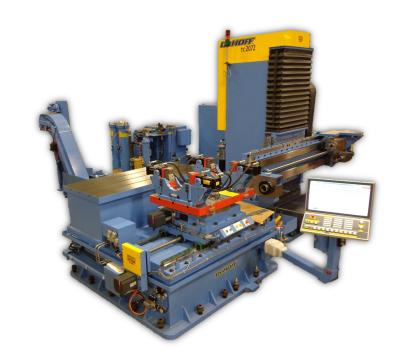
The redesigned DeHoff 2072TC is a gundrilling machine with 5-axis capability. The gundrilling spindle is mounted on a traveling column to provide the X-axis and Y-axis movement. A CAT 40 spindle is also mounted on the traveling column to enable secondary operations like milling and tapping. The machine is suitable for drilling complex hole patterns, like those seen in heat exchangers, manifolds and molds.
The 2072TC has a 2-inch (50.8 mm) gundrilling capacity and a 72-inch (1,829 mm) slide travel. The traveling column provides 60 inches (1,524 mm) of X-axis travel and 46 inches (1,168 mm) of Y-axis travel. Workpiece fixturing options include a stationary T-slot table and a rotary table with self-centering hydraulic vises. The rotary table provides B-axis rotation, and is mounted on a W-axis slide to provide clearance when rotating a long workpiece. Load capacity for the entire work table is 9,000 lbs. (4,082 kg).
The machine features a cast iron drill head base with hardened and ground steel box ways, plus hand-scraped and fitted saddle, gibs, and straps (versus linear guide ways and milled surfaces). This results in superior vibration damping, extended tool life, and improved accuracy and surface finish. Standard elements are also included on the DeHoff 2072TC, such as a high-pressure coolant system and Beckhoff controls with G-Code programming capability.
Contact Details
Related Glossary Terms
- G-code programming
G-code programming
Programs written to operate NC machines with control systems that comply with the ANSI/EIA RS-274-D-1980 Standard. A program consists of a series of data blocks, each of which is treated as a unit by the controller and contains enough information for a complete command to be carried out by the machine.
- clearance
clearance
Space provided behind a tool’s land or relief to prevent rubbing and subsequent premature deterioration of the tool. See land; relief.
- coolant
coolant
Fluid that reduces temperature buildup at the tool/workpiece interface during machining. Normally takes the form of a liquid such as soluble or chemical mixtures (semisynthetic, synthetic) but can be pressurized air or other gas. Because of water’s ability to absorb great quantities of heat, it is widely used as a coolant and vehicle for various cutting compounds, with the water-to-compound ratio varying with the machining task. See cutting fluid; semisynthetic cutting fluid; soluble-oil cutting fluid; synthetic cutting fluid.
- gang cutting ( milling)
gang cutting ( milling)
Machining with several cutters mounted on a single arbor, generally for simultaneous cutting.
- gundrilling
gundrilling
Drilling process using a self-guiding tool to produce deep, precise holes. High-pressure coolant is fed to the cutting area, usually through the gundrill’s shank.
- milling
milling
Machining operation in which metal or other material is removed by applying power to a rotating cutter. In vertical milling, the cutting tool is mounted vertically on the spindle. In horizontal milling, the cutting tool is mounted horizontally, either directly on the spindle or on an arbor. Horizontal milling is further broken down into conventional milling, where the cutter rotates opposite the direction of feed, or “up” into the workpiece; and climb milling, where the cutter rotates in the direction of feed, or “down” into the workpiece. Milling operations include plane or surface milling, endmilling, facemilling, angle milling, form milling and profiling.
- tapping
tapping
Machining operation in which a tap, with teeth on its periphery, cuts internal threads in a predrilled hole having a smaller diameter than the tap diameter. Threads are formed by a combined rotary and axial-relative motion between tap and workpiece. See tap.






